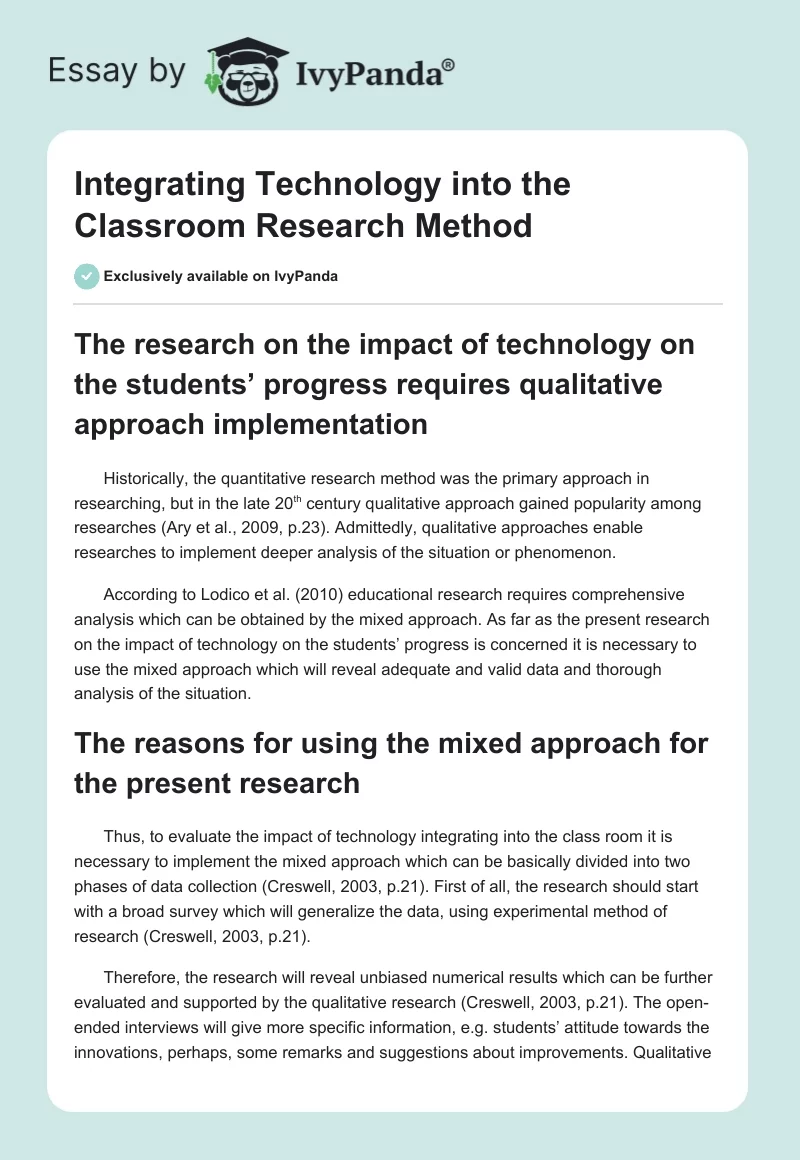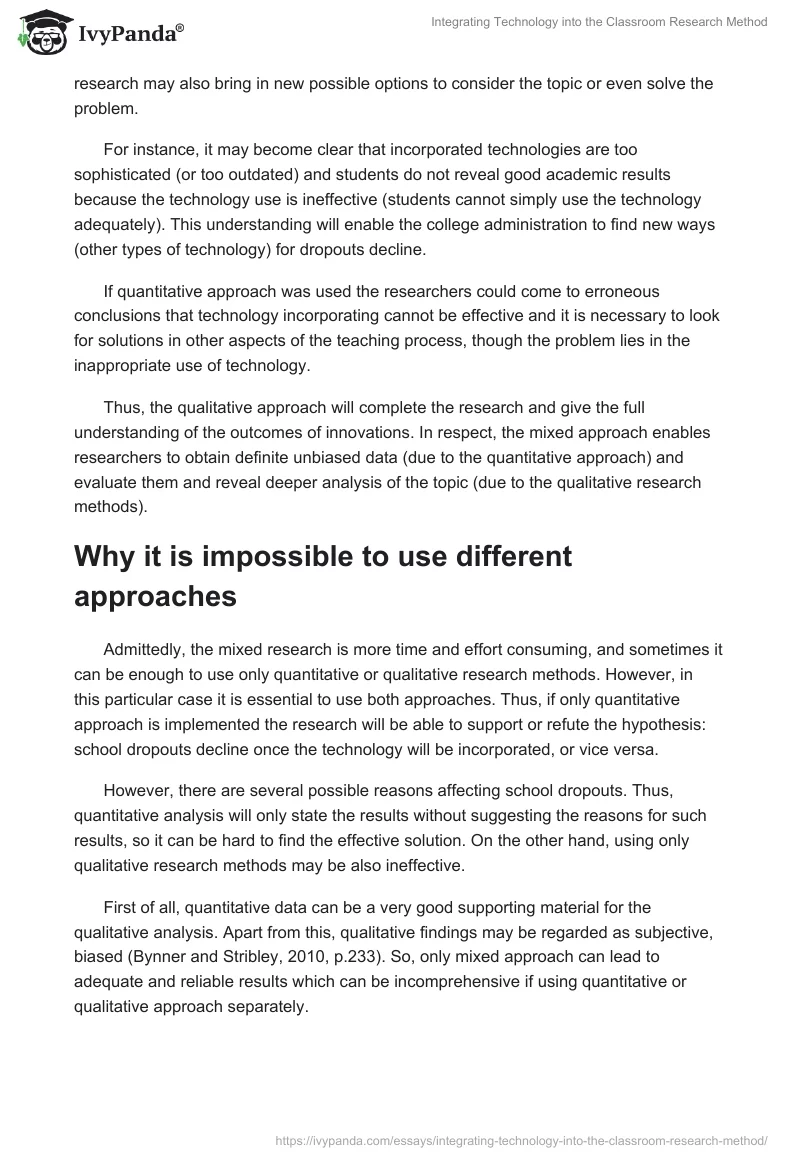The research on the impact of technology on the students’ progress requires qualitative approach implementation
Historically, the quantitative research method was the primary approach in researching, but in the late 20th century qualitative approach gained popularity among researches (Ary et al., 2009, p.23). Admittedly, qualitative approaches enable researches to implement deeper analysis of the situation or phenomenon.
According to Lodico et al. (2010) educational research requires comprehensive analysis which can be obtained by the mixed approach. As far as the present research on the impact of technology on the students’ progress is concerned it is necessary to use the mixed approach which will reveal adequate and valid data and thorough analysis of the situation.
The reasons for using the mixed approach for the present research
Thus, to evaluate the impact of technology integrating into the class room it is necessary to implement the mixed approach which can be basically divided into two phases of data collection (Creswell, 2003, p.21). First of all, the research should start with a broad survey which will generalize the data, using experimental method of research (Creswell, 2003, p.21).
Therefore, the research will reveal unbiased numerical results which can be further evaluated and supported by the qualitative research (Creswell, 2003, p.21). The open-ended interviews will give more specific information, e.g. students’ attitude towards the innovations, perhaps, some remarks and suggestions about improvements. Qualitative research may also bring in new possible options to consider the topic or even solve the problem.
For instance, it may become clear that incorporated technologies are too sophisticated (or too outdated) and students do not reveal good academic results because the technology use is ineffective (students cannot simply use the technology adequately). This understanding will enable the college administration to find new ways (other types of technology) for dropouts decline.
If quantitative approach was used the researchers could come to erroneous conclusions that technology incorporating cannot be effective and it is necessary to look for solutions in other aspects of the teaching process, though the problem lies in the inappropriate use of technology.
Thus, the qualitative approach will complete the research and give the full understanding of the outcomes of innovations. In respect, the mixed approach enables researchers to obtain definite unbiased data (due to the quantitative approach) and evaluate them and reveal deeper analysis of the topic (due to the qualitative research methods).
Why it is impossible to use different approaches
Admittedly, the mixed research is more time and effort consuming, and sometimes it can be enough to use only quantitative or qualitative research methods. However, in this particular case it is essential to use both approaches. Thus, if only quantitative approach is implemented the research will be able to support or refute the hypothesis: school dropouts decline once the technology will be incorporated, or vice versa.
However, there are several possible reasons affecting school dropouts. Thus, quantitative analysis will only state the results without suggesting the reasons for such results, so it can be hard to find the effective solution. On the other hand, using only qualitative research methods may be also ineffective.
First of all, quantitative data can be a very good supporting material for the qualitative analysis. Apart from this, qualitative findings may be regarded as subjective, biased (Bynner and Stribley, 2010, p.233). So, only mixed approach can lead to adequate and reliable results which can be incomprehensive if using quantitative or qualitative approach separately.
The influence of the research consumer on the choice of the research method
The importance of the research findings validity can be also illustrated by the relationship between a producer of the research and a consumer of the research. Thus, the producer considers the topic collecting and evaluating data. The consumer of the research is the person who knows something concerning the issues considered in the research (Walpole and McKenna, 2004, p.45). As a rule, research consumers are the target audience for the research producer.
Sometimes research consumers may be interested in the research and wait for the research results. Such research consumers can influence the producer of the research. Thus, the producer may choose the research approach in accordance with the consumer’s expectations. If the definite quantitative data is expected, the producer is likely to choose the quantitative approach. Admittedly, quantitative data are unbiased and objective (Bynner and Stribley, 2010, p.233).
Moreover, quantitative research method does not require as much time as qualitative approach. Of course, if some deeper understanding of the issue is required the producer will choose the qualitative approach. Thus, the validity of the research findings will depend on the consumer’s expectations.
Being an educational research, the present research requires the mixed approach
Thus, it is clear that the most effective approach for the present research is the mixed approach which enables the researcher to obtain definite data and analyze them comprehensively reaching deep understanding of the issue.
Moreover, in the majority of cases educational researches require the mixed approach since this research method enables researchers to understand not only outcomes, but the reasons for the existing problem. However, it is necessary to add that when definite data is required researches should implement quantitative research to provide research consumers with particular quantitative findings.
Reference List
Ary, D., Jacobs, L.C., Razavieh, A., Sorensen, C. (2009). Introduction to Research in Education. Belmont: Cengage Learning.
Bynner, J., Stribley, K. (2010). Research Design: The Logic of Social Inquiry. New Jersey: Aldine Transaction.
Creswell, J.W. (2003). Research Design: Qualitative, Quantitative, and Mixed Method Approaches. Thousand Oaks, California: SAGE.
Lodico, M., Spaulding, D. T., & Voegtle, K. H. (2010). Methods in Educational Research: From Theory to Practice (Laureate Education, Inc., custom ed.). San Francisco, CA: John Wiley & Sons.
Walpole, S., McKenna, M.C. (2004).The Literacy Coach’s Handbook: a Guide to Research-Based Practice. New York, NY: Guilford Press.


